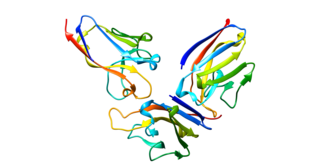Pattern recognition receptors (PRRs) play a crucial role in the proper function of the innate immune system. PRRs are germline-encoded host sensors, which detect molecules typical for the pathogens. They are proteins expressed mainly by cells of the innate immune system, such as dendritic cells, macrophages, monocytes, neutrophils, as well as by epithelial cells, to identify two classes of molecules: pathogen-associated molecular patterns (PAMPs), which are associated with microbial pathogens, and damage-associated molecular patterns (DAMPs), which are associated with components of host's cells that are released during cell damage or death. They are also called primitive pattern recognition receptors because they evolved before other parts of the immune system, particularly before adaptive immunity. PRRs also mediate the initiation of antigen-specific adaptive immune response and release of inflammatory cytokines.

C-type lectin domain family 7 member A or Dectin-1 is a protein that in humans is encoded by the CLEC7A gene. CLEC7A is a member of the C-type lectin/C-type lectin-like domain (CTL/CTLD) superfamily. The encoded glycoprotein is a small type II membrane receptor with an extracellular C-type lectin-like domain fold and a cytoplasmic domain with a partial immunoreceptor tyrosine-based activation motif. It functions as a pattern-recognition receptor for a variety of β-1,3-linked and β-1,6-linked glucans from fungi and plants, and in this way plays a role in innate immune response. Expression is found on myeloid dendritic cells, monocytes, macrophages and B cells. Alternate transcriptional splice variants, encoding different isoforms, have been characterized. This gene is closely linked to other CTL/CTLD superfamily members on chromosome 12p13 in the natural killer gene complex region.

NKG2-F type II integral membrane protein is a protein that in humans is encoded by the KLRC4 gene.

Leukocyte immunoglobulin-like receptor subfamily B member 4 is a protein that in humans is encoded by the LILRB4 gene.

C-type lectin domain family 11 member A is a protein that in humans is encoded by the CLEC11A gene.

Hematopoietic cell signal transducer is a protein that in humans is encoded by the HCST gene.

Leukocyte immunoglobulin-like receptor subfamily B member 3 is a protein that in humans is encoded by the LILRB3 gene.

Sialic acid-binding Ig-like lectin 9 is a protein that in humans is encoded by the SIGLEC9 gene.

Signal-regulatory protein beta-1 is a protein that in humans is encoded by the SIRPB1 gene. SIRPB1 has also recently been designated CD172B.

Leukocyte immunoglobulin-like receptor subfamily A member 2 is a protein that in humans is encoded by the LILRA2 gene.

C-type lectin domain family 2 member D is a protein that in humans is encoded by the CLEC2D gene.

Paired immunoglobulin-like type 2 receptor beta is a protein that in humans is encoded by the PILRB gene.

C-type lectin domain family 1 member A is a protein that in humans is encoded by the CLEC1A gene.

Sialic acid-binding Ig-like lectin 10 is a protein that in humans is encoded by the SIGLEC10 gene. Siglec-G is often referred to as the murine paralog of human Siglec-10

C-type lectin domain family 2 member B is a protein that in humans is encoded by the CLEC2B gene.

CD300A is a human gene.

C-type lectin domain family 12 member A is a protein that in humans is encoded by the CLEC12A gene.

Leukocyte immunoglobulin-like receptor subfamily B member 5 is a protein that in humans is encoded by the LILRB5 gene.

Paired immunoglobin like type 2 receptor alpha is a protein that in humans is encoded by the PILRA gene.

Dectin-2 or C-type lectin domain containing 6A is a protein that in humans is encoded by the CLEC6A gene. Dectin-2 is a member of the C-type lectin/C-type lectin-like domain (CTL/CTLD) superfamily. The encoded protein is a type II transmembrane protein with an extracellular carbohydrate recognition domain. It functions as a pattern recognition receptor recognizing α-mannans and as such plays an important role in innate immune response to fungi. Expression is found on macrophages and dendritic cells. It can also be found at low levels in Langerhans cells and peripheral blood monocytes, where expression levels could be increased upon induction of inflammation.











